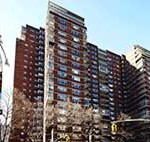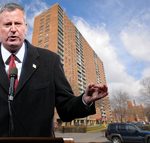 Trio charged in bribery scheme at Mitchell-Lama complex in Coney Island
Trio charged in bribery scheme at Mitchell-Lama complex in Coney Island
Trending
City rescues struggling affordable co-op in Brooklyn Heights
Affordable Cadman Towers owes $62M, can’t borrow for repairs

Mitchell-Lama co-ops are hailed as one of New York’s most successful models of affordable housing. But they are not immune to the harsh realities of real estate ownership.
Case in point: Cadman Towers, a 421-unit building at 10 Clinton Street in Brooklyn Heights.
Residents bought into the building for next to nothing — one couple, an artist and a teacher, paid $6,000 two decades ago, when they were in their 50s. Annual property taxes average a little more than $300 per unit.
By comparison, free-market apartments in the expensive Brooklyn neighborhood range from $375,000 to more than $1 million, and their tax bills run into the thousands. Because Mitchell-Lamas are so inexpensive, the waiting list to buy into one is years long.
For Cadman Towers, the model worked until it didn’t. The City reported that millions of dollars’ worth of deferred maintenance has piled up, and the building, which has a $62 million mortgage coming due, can’t borrow more to pay for repairs.
Normally, a large apartment building in Brooklyn Heights could refinance for a much larger amount. But, to keep units affordable, the state law that established the Mitchell-Lama program in 1955 severely limits resale prices. As a result, the co-ops’ borrowing capacity is also limited because residents have little equity.
Cadman Towers’ board tried raising the monthly dues to pay for building upkeep, but many residents have low incomes — that’s how they qualified to join the co-op in the first place.
A more attractive option was to raise the cap on resales, which requires leaving the Mitchell-Lama program. More than three-quarters of 10 Clinton Street shareholders voted to instead become a city-sponsored co-op called an HDFC, the City reported.
Rather than sell their one-bedrooms for about $45,000 or their three-bedrooms for $80,000, shareholders will be able to sell for amounts affordable to buyers earning 80 percent of the area median income. Half of the profit will go to the building. That should bring in about $1 million annually, and taxpayers will continue to subsidize the co-op.
The local City Council member, Lincoln Restler, signed off, and on Thursday the Council approved a tax break to enable the switch. “We have a choice to make between hurting the existing low-income residents at Cadman or hurting future low-income residents who want to live at Cadman,” Restler told the publication.
He was referring to the New Yorkers who have spent years on the waiting list to buy into Cadman Towers. The change wiped out that list. Future buyers will be determined by the city’s housing lottery.
Read more
 Trio charged in bribery scheme at Mitchell-Lama complex in Coney Island
Trio charged in bribery scheme at Mitchell-Lama complex in Coney Island
 Millionaires exploiting Mitchell-Lama housing program: audit
Millionaires exploiting Mitchell-Lama housing program: audit
 Mayor’s love affair with affordable housing continues: city sets aside $250M to preserve Mitchell-Lama units
Mayor’s love affair with affordable housing continues: city sets aside $250M to preserve Mitchell-Lama units




